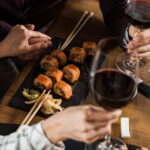Rosengarten Classic. Originally Published: ROSENGARTEN REPORT, April 2001.
Dim Sum that Really Touch My Heart
Cantonese Dim Sum…a magical and wonderful collection of little bites…that can be completely confusing to order! Many friends skip Dim Sum completely because they just don’t know what to choose. If you go to a place that wheels carts around, ordering is more of a point and hope; you can just point at what looks good—and hope it’s delicious. If you go to a dim sum place where you order from the kitchen, however, you really need to know your dim sum.
This guide to my faves—which goes beyond the standard potstickers and shu mai includes transliterations of the Cantonese names in case you’re in a no-English zone (which is where the best dim sum usually is!)
Ha Gow
The famous shrimp dumplings, sometimes called “crystal” dumplings because of the pearly, see-through wrapper made from wheat flour with added tapioca. Light, slightly sticky, naturally sweet, wonderful symphony of textures.
Cheung Fun
Flat, egg roll-sized rolls of specially made rice dough, also pearly (it’s a ground rice/potato starch mixture steamed on white cotton sheets). Think manicotti in shape…the steamed rolls are usually filled with shrimp or beef. Slippery and delightful. Soy sauce drizzled on top. Hard to handle, so cut into pieces with your chopstick before picking up.
Seen Juk
Amazing, stretchy, resilient, chewy-tender, yellowish sheets industrially made from bean curd used in different ways as dim sum wrappers. You must try them. I’ve enjoyed them pan-fried (with ground pork and vegetables inside) and deep-fried and even had some great ones with pieces of shrimp and stalks of Chinese greens inside.
Lor Bak Go
Commonly called “turnip cake,” this great, jiggly, quivering individual-portion square is actually made from grated daikon, rice flour and wheat flour. The “cake” usually contains some funky protein, like Chinese sausage or dried shrimp. It is one of the great dim sum house production numbers; a rolling griddle comes by your table, where the square is cooked to a crusty brown on the outside—a wonderful contrast to the turnip-y custard-like mass within.
Tsa Yeun Dau Fu
Another texture trip. Little cubes of soft bean curd stuffed with something, usually shrimp or pork then deep-fried—creating a light, crunchy chew on the outside, and a meltingly tender, custard-like chew on the inside.
Si Jup Pai Guat
I love these little bite-sized bits of spare ribs (but don’t bite too quickly—they have bones.) Tossed with fermented black beans, garlic, sugar, diced red pepper and steamed; there’s usually a little cornstarch in the mix, which creates a slightly mucillaginous texture that I love. Don’t miss these miniature flavor bombs.
Ngao Yuk
Dim sum neophytes are sometimes surprised by these—because they seem less “Chinese” than other items. Basically, they are golfball-sized meat balls made from beef—steamed, reddish inside, with a wonderful, haunting flavor, enhanced by a little lemon rind. Most important is the texture—soft, spongy, slightly gummy, not unlike a certain type of un-crumbly meat loaf. The Chinese connection is further weakened by the traditional drizzle: Worcestershire sauce. But the whole package, despite its Western leanings, is delicious and another must-order.
Photos Via: Bigstockphoto, kake.dreamwidth










